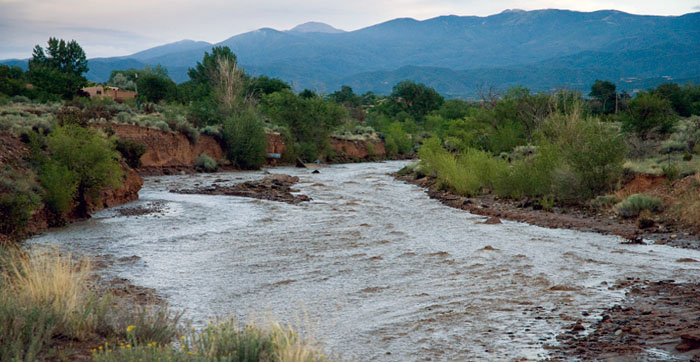
Water on the Move
Students use their school campus as a study site for learning about rainfall and where rain water flows or is absorbed. Students measure and calculate the area of their site; set up rain gauges to measure rainfall and follow the path water takes.Students also use weather data found online. This is a STEM activity with Field Investigation.
Overview

Flash flooding in the Rio Santa Fe. Photo by Marti Niman.
Grade level: 5th-8th grade
Content Areas: Science, Math, English Language Arts, Technology
Objectives: Students will:
1. Establish understanding of water cycle.
2. Measure and mark off study site; then calculate area of study site.
3. Use rain gauges to measure rainfall at two locations on site– one on hard surface and the other on grassy area.
4. Make periodic observations of amount of precipitation that runs off or is pooled, and/or is absorbed on study site.
5. Observe the path that rain runoff follows at two locations on site.
6. Compare runoff rates at two locations.
7. Calculate volume of rain water from use of rain gauges.
8.Explore why it matters where rainfall runoff goes.
9. Participate in class discussions about how rain water recharges underground aquifers as well as flowing to nearby streams that may flow into larger rivers-refer back to water cycle.
10. Discuss how rain water supports wildlife habitat on their school campus and in their community.
11. Discuss both positive and negative effects of rain events, including flash floods.
Method: Students measure and calculate the area of a study site on school campus. They calculate the volume of water that falls on study site and determine annual rainfall through research. Students consider relationships between rainfall and runoff, including effects on habitats and wildlife. Students use trundle wheel measures, metric and standard measures, calculators and rain gauges. See alternative method using sprinklers in case of no rain.
Materials for Introduction of Lesson:
[wpfilebase tag=file id=1894 tpl=filebrowser /] [wpfilebase tag=file id=1893 tpl=filebrowser /] • Computers for research
• Student calculation sheet
• Measuring tools such as trundle wheels
• Flagging tape or twine
• Calculators
• Graph paper
• Rain gauges
• Science recording journals
• Water cycle poster
Lesson and Activity Time: Three classroom sessions to introduce vocabulary, review water cycle, choose locations to set up rain gauge and measure area of two study locations on school campus. Additional time will be needed throughout the season or year to periodically check gauges after rain events and to make observations.
Location: Outside on or near school grounds.
Academic Standards: [wpfilebase tag=file id=2076 tpl=filebrowser /]
Vocabulary
Natural resources, water cycle, precipitation, evaporation, condensation, runoff, inflow, recharge, impervious, pervious, porous, erosion, deposition, sediment
Background
One of New Mexico’s most valuable natural resources is its water supply. New Mexico is a normally dry state that experiences periodic droughts – some of which can be severe. This lesson will help students understand the relationships between our water resources, the water cycle and the water needs of people and of wildlife.
• Many species of wildlife (not just fish and other aquatic dwelling wildlife) depend on water found in healthy, functioning streams, rivers and reservoirs.
• It is estimated that 80% of New Mexico wildlife and birds spend all or part of their lives in riparian (woodlands along waterways) habitats.
• A major issue of concern is how humans affect the quality and quantity of water that eventually reaches aquatic habitats.
• New Mexico is critically dependent on winter snow pack for fisheries health, irrigation for agriculture and city water supplies.
• Developing an understanding of precipitation and runoff is an important part of understanding the water cycle (See Procedures and Resources for sources of water cycle posters).
• Rainfall is one form of precipitation and is one way water re-enters aquatic, wildlife habitats.
• The lateral movement of rainfall is runoff and finds its way into streams, rivers, and lakes. Vertical movement seeps into the soil and porous rock and recharges groundwater supplies.
• Runoff waters are necessary to renew the many aquatic habitats that depend on the inflow of water for continuity. Inflow supports aquatic life by preventing lakes from shrinking because of evaporation and by preventing streams from going below minimum flow levels.
• Since runoff is the dominant way that water flows from one location to another, many pollutants find their way into moving waters. These types of pollutants are known as “non-point source.” Examples include garden insecticides, automobile oils and fluids, and paints. An often overlooked source of pollution during runoff is animal waste, especially dog waste that owners have not picked up. These are washed by runoff into streams, rivers, lakes and eventually to oceans.
• Runoff is also responsible for the erosion, transportation, and deposition of sediments washed away from the land’s surface. Certain land practices along with development often leave bare ground ready for the topsoil to be washed away. Paving and compacted soil can reduce an area’s water absorbing ability. This increases runoff and reduces the absorption rates, thereby adversely affecting vegetation and groundwater recharge.
Procedure
Setting the Stage:
1. Introduce lesson with graphic of the water cycle using available water cycle posters that can be obtained from most municipal water departments or the USGS web site (http://ga.water.usgs.gov/edu/).
2. Discuss water cycle vocabulary: precipitation, runoff, surface and ground water, evapotranspiration, evaporation, condensation, etc.
3. Discuss and explain meanings of impervious and pervious and point out these areas on school campus site. For example, paved areas are impervious. Natural grassy areas or areas with soft soil are pervious. Note that any dirt area where it is hard and compacted is considered impervious since rainfall cannot penetrate it.
Student Work:
4. Students find 1 to 2 study sites on school campus. These should be areas with different surfaces and where the rain gauge will not be disturbed and where the flagging tape or twine can stay in place for a while. One site is sufficient if it has both impervious and pervious surfaces.
5. Once the site(s) are determined by students and teacher, the length and width of each area should be measured using tools that are available. Using twine or flagging tape, students can measure and mark every 3 feet. If a trundle wheel is available, it is the most convenient tool for measuring. The main difficulty with calculating area comes from irregularly shaped study sites. If site has irregular shapes, try to leave those out and measure area that is rectangular.
Use [wpfilebase tag=file id=1894 tpl=filebrowser /] forms throughout the investigation.
6. After the study areas are marked and measured, determine the amount of rain that falls in the areas using these suggested options:
a. Obtain the rainfall averages using information from resource agencies such as the National Weather bureau, local or state soil conservation service, local meteorologists, state hydrologists or local newspapers. One reliable source is www.usclimatedata.com.
b. Using the annual average for your location (for example, Santa Fe, NM), complete calculations for volume of rain on [wpfilebase tag=file id=1894 tpl=filebrowser /].
Go here for climate data: http://www.usclimatedata.com/climate/new-mexico/united-states/3201c. Measure the amount of rain with a rain gauge and record rain over a period of time.c. Measure the amount of rain with a rain gauge and record rain over a period of time Calculate an average. You may need to simulate rain by using sprinklers, if no rain falls during project time.
d. Calculate the amount of rain that falls in a given storm when using rain gauges and repeat calculations for volume of rain.
7. Discuss historical rain events in the region. This will be helpful if no significant rain falls during time allotted. One example from the Cloudcroft area occurred in 1941. Canyons were eroded during that rain storm and are still noticeable.
8. Class discussion on where the runoff rainfall flows to for your site. This could be a nearby arroyo, a drain or ditch or a stream. Make predictions on wildlife living in these areas that could benefit from the water.
Lesson Assessments and Extensions:
9. Discuss questions and topics for deeper investigation and research. Students record the results of their investigations, class discussion notes, and written reports in science notebooks:
a. How does the volume of rain for the measured site compare between the climate data averages and your actual rain event measured volume?
b. Since New Mexico typically does not receive large amount of dependable rain, and since drought conditions often occur and persist for long periods of time, why would it be important to ensure that your school site’s rainfall does not just runoff, but rather collect in areas where it can be absorbed and add to plant growth?
c. What could you do as a student group to change your school campus to allow for more pervious natural areas?
d. Where does the water from rainfall go when it leaves the study site?
e. How much water is absorbed by the different surfaces on the study site? If there are two sites, how do they compare? How are they different?
f. What types of potential pollutants does the water come in contact with? (Is there a school parking lot nearby where automotive oils could runoff during rain events)?
g. Where is the location of the nearest wildlife habitat that receives the site’s runoff? (Is it a nearby arroyo?)
h. Conduct research on wildlife in your area that benefits from rain runoff.
i. How do people use the water between the time it leaves the site and arrives in the wildlife habitat?
j. What are some of the positive and negative effects that the water may have on the whole environment at various points on its journey? (Consider flash flooding that occurs in New Mexico).
Assessment
Technology and Extensions:
• Use the Internet to obtain local rainfall data
• Use spreadsheet software to record and graph the rainfall data
• Complete additional math calculations for study site. See [wpfilebase tag=file id=1893 tpl=filebrowser /] –extended calculations for impervious versus pervious surfaces.
• Obtain student copies of Discover the Waters of New Mexico, a Project WET publication, from New Mexico Water Conservation Alliance and the NM Office of the State Engineer. This 14-page booklet covers important water topics such as watersheds, western water law, water movement and nature’s needs–all at appropriate level for elementary school.
Resources
• Many local stores sell rain gauges, such as hardware and department stores
• Acorn Naturalists online science store sells an economical student rain gauge
• Web sites with directions to make rain gauges include: www.wierdsciencekids.com and www.kidsgardening.org
• An excellent water cycle video from National Science Foundation. It includes visuals and vocabulary. It is highly recommended for all students to watch. http://www.nsf.gov/news/mmg/mmg_disp.cfm?med_id=74613
• USGS Water Science School with abundant resources and information about water, including water cycle poster: http://water.usgs.gov/edu/watercycle.html
• This is printable PDF of water cycle: http://water.usgs.gov/edu/watercycle-kids.html. It prints 8 ½”x 11” so each student can have a copy.
Credits: Adapted from Project WILD-Aquatic activity, Where Does Water Run?


